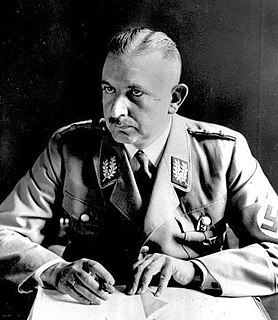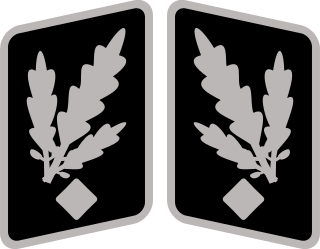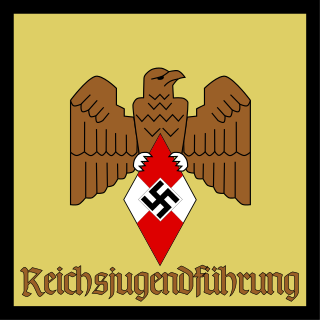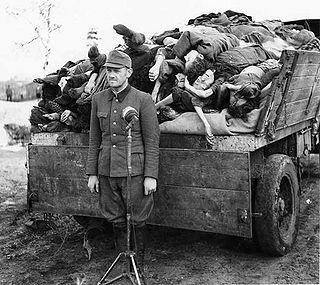 W
WRanks and insignia of the Nazi Party were paramilitary titles used by the National Socialist German Workers' Party (NSDAP) between approximately 1928 and the fall of Nazi Germany in 1945. Such ranks were held within the political leadership corps of the Nazi Party, charged with the overseeing the regular Nazi Party members.
 W
WThe uniforms and insignia of the Schutzstaffel were paramilitary ranks and uniforms used by the Schutzstaffel (SS) between 1925 and 1945 to differentiate that organization from the regular German armed forces, the German state, and the Nazi Party.
 W
WThe uniforms and insignia of the Sturmabteilung (SA) were Nazi Party paramilitary ranks and uniforms used by SA stormtroopers from 1921 until the fall of Nazi Germany in 1945. The titles and phrases used by the SA were the basis for paramilitary titles used by several other Nazi paramilitary groups, among them the Schutzstaffel (SS). Early SS ranks were identical to the SA, since the SS was originally considered a sub-organization of the Sturmabteilung.
 W
WThe ranks and insignia of the National Socialist Motor Corps were a paramilitary rank system in Germany used between the years of 1931 and 1945. They were based closely on the ranks and insignia of the Sturmabteilung (SA), of which the NSKK was originally a part.
 W
WBlockführer was a paramilitary title of the SS, specific to the Totenkopfverbande. An SS-Blockführer was typically in charge of a prisoner barracks ranging from two hundred to three hundred concentration camp prisoners; in larger camps, this number could be as a high as 1000. The Blockführer was in charge of daily attendance, supervising daily work details, and distributing rations to prisoners. Assisting in this case were several prisoner trustees, known as Kapos. The position of Blockführer was usually held by an SS-soldier holding the rank of Unterscharführer or non-commissioned officer rank of Scharführer.
 W
WGruppenführer was an early paramilitary rank of the Nazi Party (NSDAP), first created in 1925 as a senior rank of the SA. Since then, the term Gruppenführer is also used for leaders of groups/teams of the police, fire departments, military and several other organizations.
 W
WThis article lists the commanders of the Sturmabteilung, a paramilitary wing of the Nazi Party (NSDAP), between the years of 1920 and 1945.
 W
WRanks and insignia of the Reichsarbeitsdienst were paramilitary ranks used by the Reich Labour Service.
 W
WReichsjugendführer was the highest paramilitary rank of the Hitler Youth. On 30 October 1931, Hitler appointed Baldur von Schirach as the Reich Youth Leader of the Nazi Party. In 1933, after the Nazi seizure of state power, all youth organizations in Germany were brought under Schirach's control and he was designated the Jugendführer des Deutschen Reiches on 17 June. When Schirach was named Gauleiter of the Reichsgau Vienna on 8 August 1940, Artur Axmann succeeded him as Reichsjugendführer. Axmann had served as Schirach's deputy since 1 May 1940.
 W
WRLB-Präsident, also known as Reichsluftschutzbund Präsident or Präsident der RLB, was a Nazi paramilitary rank which was held by the supreme commander of the Reichsluftschutzbund. The position of RLB-Präsident was the highest rank of the Reichsluftschutzbund and was also considered a senior ministerial position within the Aviation Ministry of the Nazi Germany government.
 W
WSchutzhaftlagerführer was a paramilitary title of the SS, specific to the concentration and extermination camps Totenkopfverbande. A Schutzhaftlagerführer was in charge of the economic function of the camp. Usually, there was more than one SS man performing that function at each location due to their enormous size. Schutzhaftlagerführers received orders from the central offices in Berlin, such as DEST run directly by the SS. Prisoners' lives were entirely in their hands. Their orders, which usually involved routine maltreatment of condemned victims, were carried out through "assignments" so they would not have to deal with the dead resulting from them.
 W
WSS-Stabsscharführer was not a rank, but a position title or appointment, mainly used in the Waffen-SS, equivalent to the Hauptfeldwebel of the Wehrmacht between the years of 1938 to 1945.
 W
WStabschef was an office and paramilitary rank in the Sturmabteilung (SA), the paramilitary stormtroopers associated with the Nazi Party. It was a rank and position held by the operating chief of the SA. The rank is equivalent to the rank of Generaloberst in the German Army and to General in the US Army.
 W
WOrganisation Todt (OT) was a civil and military engineering organisation in Nazi Germany from 1933 to 1945, named for its founder, Fritz Todt, an engineer and senior Nazi. The organization was responsible for a huge range of engineering projects both in Nazi Germany and in occupied territories from France to the Soviet Union during World War II. It became notorious for using forced labour. From 1943 until 1945 during the late phase of the Third Reich, OT administered all constructions of concentration camps to supply forced labor to industry.
 W
WUntergruppenführer was a rare and short lived rank of the Sturmabteilung which existed in the SA for a few months in late 1929 and 1930. The rank was created as an intermediary position between the ranks of SA-Oberführer and SA-Gruppenführer. The rank was held by those Oberführer who were selected to command the early SA-brigades first formed in 1929. There was no prescribed insignia for those holding the rank, with the Untergruppenführer continuing to wear the uniform of an SA-Oberführer.